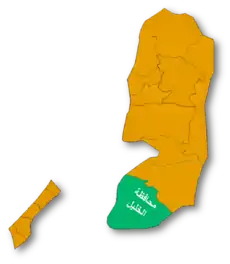Tarrama | |
|---|---|
Local Development Committee | |
| Arabic transcription(s) | |
| • Arabic | طرّامة |
| • Latin | Khirbet al-Tarramah (official) |
 Tarrama Location of Tarrama within Palestine | |
| Coordinates: 31°28′51″N 35°01′57″E / 31.48083°N 35.03250°E | |
| Palestine grid | 153/098 |
| State | State of Palestine |
| Governorate | Hebron |
| Government | |
| • Type | Local Development Committee |
| Area | |
| • Total | 210 dunams (0.2 km2 or 0.08 sq mi) |
| Population (2017)[1] | |
| • Total | 642 |
| • Density | 3,200/km2 (8,300/sq mi) |
Tarrama (Arabic: طرّامة, also known as Khirbet al-Tarramah) is a Palestinian village situated on a hilltop with an elevation of 879 meters (2,884 ft) in the southern West Bank, part of the Hebron Governorate. Located just south of Dura, nearby localities include at-Tabaqa to the north, Fawwar to the east, Khursa to the west, and Deir Razih to the south. The village had a population of 642 in 2017.[1]
Its total land area is 210 dunams and the village is provided with electricity and telephone lines.[2]
History
Khirbet Tarrama has been suggested as a possible site of the "Jezreel" mentioned as a town in the territory of Judah in the Bible.[3]
Ceramics from the Byzantine era have been found here.[4]
Ottoman era
In 1863, Victor Guérin visited.[5] In 1883, the PEF's Survey of Western Palestine (SWP) noted of Khurbet Terrama: "This ruin, not on the map, was found by Guerin about half an hour north of Khurbet Deir Razi. It was on the top of a terraced hill, and contains the remains of an old fort, with caves cut in the rock, one of which is pierced with columbaria."[6]
British Mandate era
At the time of the 1931 census of Palestine, conducted by the British Mandate authorities, the population of Kh. Tarama was counted under Dura.[7]
Jordanian era
In the wake of the 1948 Arab–Israeli War, and after the 1949 Armistice Agreements, Tarrama came under Jordanian rule.
In 1961, there were 161 residents here.[8]
Post-1967
After the Six-Day War in 1967, Tarrama has been under Israeli occupation.
During the 1970s, the Israeli Military unsuccessfully attempted to establish a military air field on Tarrama's lands to serve the al-Majnouna camp.[2]
Most of its inhabitants belong to the Awlad Muhammad extended family,[2] but over 10% were Palestinian refugees in 1997.[9]
The population increased to 404 by 1997.[10]
In 2007, Tarrama had a population of 630, according to the Palestinian Central Bureau of Statistics census.[11]
References
- 1 2 Preliminary Results of the Population, Housing and Establishments Census, 2017 (PDF). Palestinian Central Bureau of Statistics (PCBS) (Report). State of Palestine. February 2018. pp. 64–82. Retrieved 2023-10-24.
- 1 2 3 Background to Tarrama Land Research Center. 19 February 2009.
- ↑ "Jezreel". Encyclopædia Britannica. 2009. Encyclopædia Britannica Online. 5 March 2009.
- ↑ Dauphin, 1998, p. 962
- ↑ Guérin, 1869, p. 372: "nous atteignons le sommet d'une colline qui s'élève comme par gradins successifs et dont les terres sont soutenues par plusieurs murs d'appui. Un dernier mur d'enceinte, qui a été démoli, mais dont les traces sont reconnaissables, environnait jadis la plate-forme supérieure, où sont épars des amas de gros blocs disjoints, ayant appartenu à une assez puissante construction, presque entièrement détruite, qui semble avoir eu une destination militaire. On y remarque aussi plusieurs cavernes pratiquées dans le roc, une, entre autres, dont les parois sônt percées intérieurement d'une foule de petites niches semblables à des trous de pigeonnier. Ces ruines me sont désignées sous le nom de Khirbet Terrama."
- ↑ Conder and Kitchener, 1883, SWP III, p. 369
- ↑ Mills, 1932, p. 32
- ↑ Government of Jordan, Department of Statistics, 1964, p. 22
- ↑ Palestinian Population by Locality and Refugee Status Archived 2008-11-19 at the Wayback Machine Palestinian Central Bureau of Statistics (PCBS).
- ↑ Welcome to Khirbet al-Tarramah Palestine Remembered.
- ↑ 2007 PCBS Census Palestinian Central Bureau of Statistics. p.119.
Bibliography
- Conder, C.R.; Kitchener, H.H. (1883). The Survey of Western Palestine: Memoirs of the Topography, Orography, Hydrography, and Archaeology. Vol. 3. London: Committee of the Palestine Exploration Fund.
- Dauphin, C. (1998). La Palestine byzantine, Peuplement et Populations. BAR International Series 726 (in French). Vol. III : Catalogue. Oxford: Archeopress. ISBN 0-860549-05-4.
- Government of Jordan, Department of Statistics (1964). First Census of Population and Housing. Volume I: Final Tables; General Characteristics of the Population (PDF).
- Guérin, V. (1869). Description Géographique Historique et Archéologique de la Palestine (in French). Vol. 1: Judee, pt. 3. Paris: L'Imprimerie Nationale.
- Mills, E., ed. (1932). Census of Palestine 1931. Population of Villages, Towns and Administrative Areas. Jerusalem: Government of Palestine.
